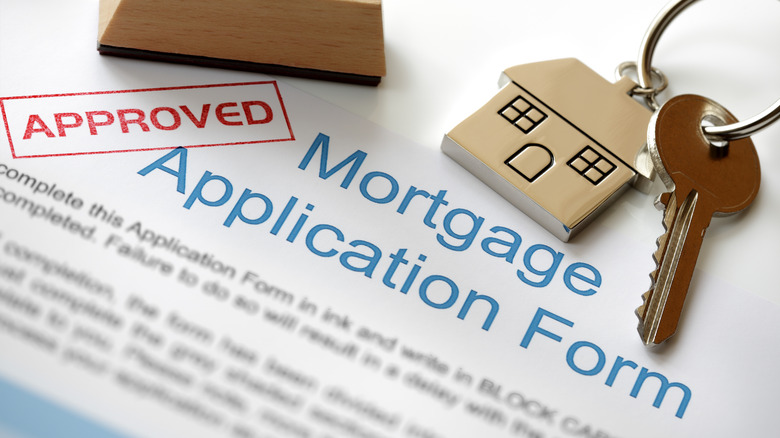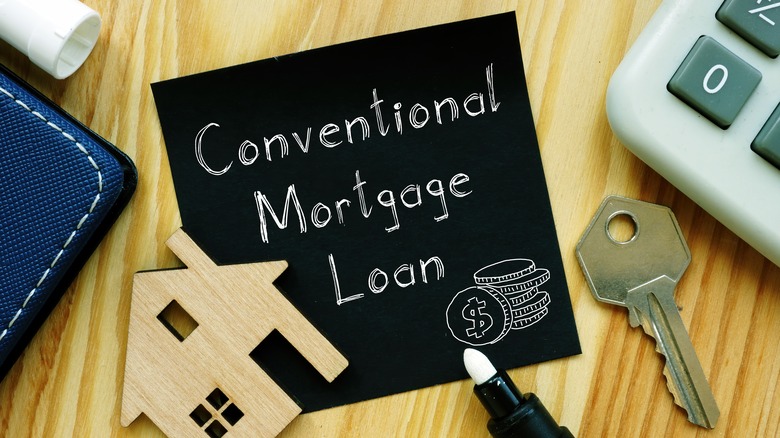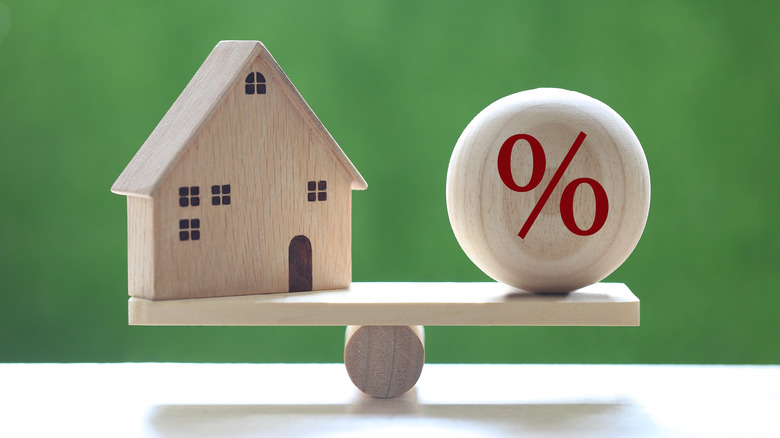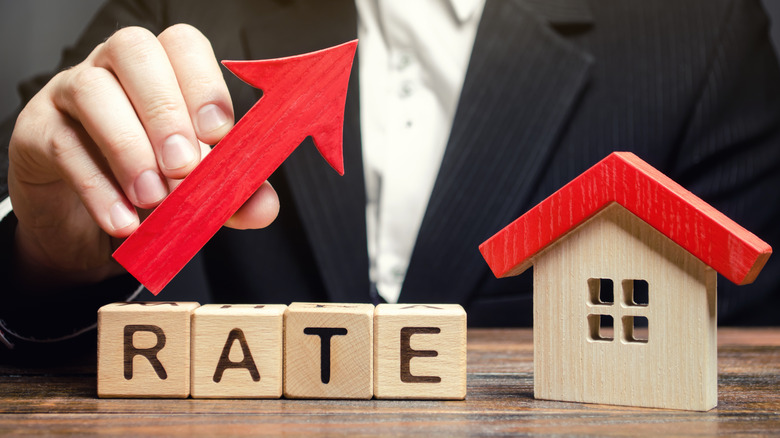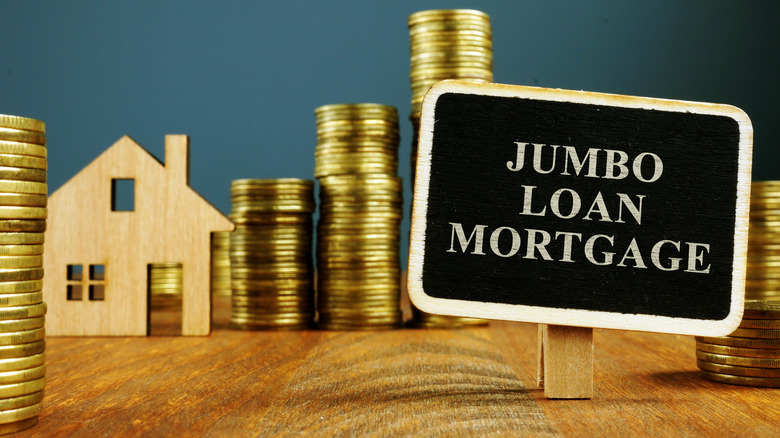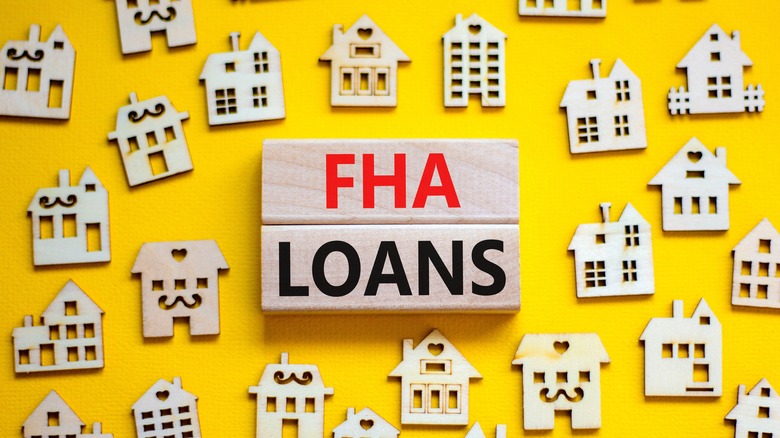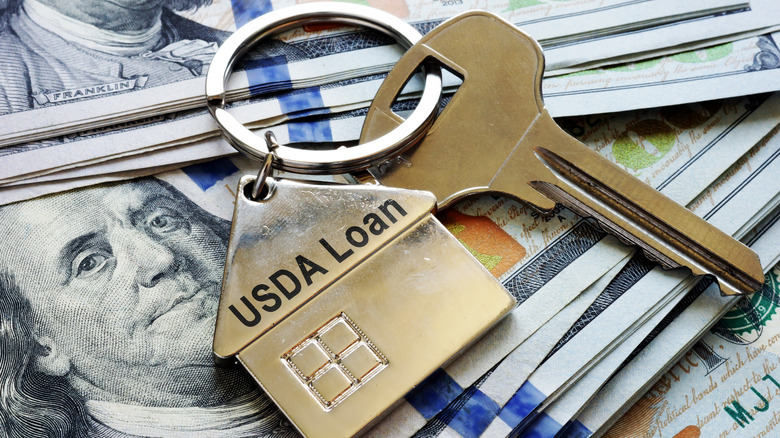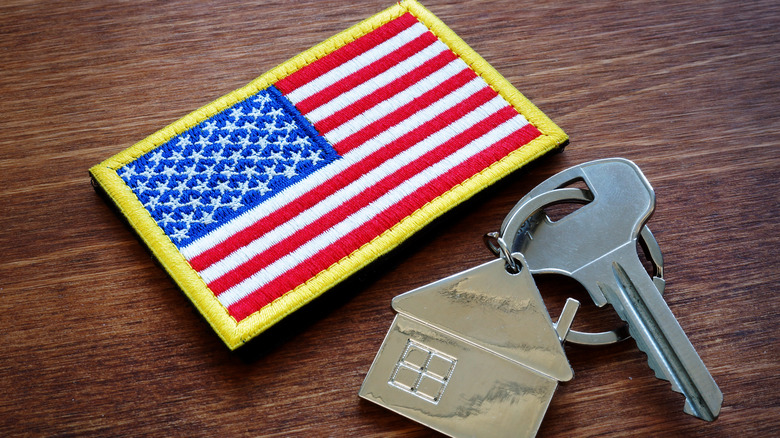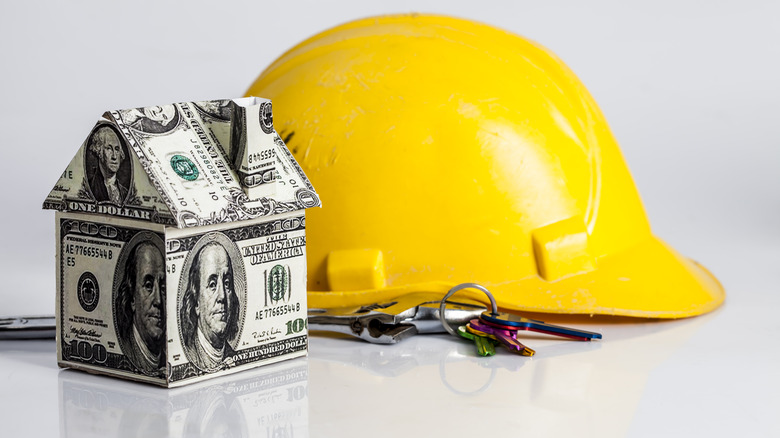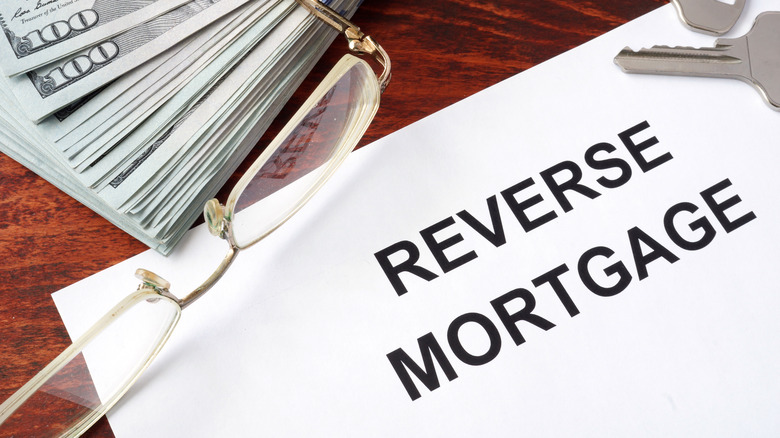The Most Popular Mortgage Types And Whether They're Right For You
Transitioning from renting to home ownership is one of the most exciting and daunting things we can experience. It's exciting because after years of needing to rely on a shoddy landlord to fix the toilet and not being allowed to repaint, suddenly, you can remodel a place to turn it into your dream home. But it's also daunting because purchasing a house is likely the biggest financial commitment most of us will ever make. We will need to take out a mortgage to make it possible. According to the Consumer Financial Protection Bureau, a mortgage is money you borrow from a lender, typically a bank, to pay for your home upfront. The home itself is considered collateral for the loan. This means that if you fail to make your repayments, the mortgage lender can take possession of the property to recoup its losses.
Most loan terms are 30 years long, but some are as little as 15, and in some cases, up to 40 years. The loan is divided into agreed-upon payments, typically monthly, which include both principal (the amount you borrowed) and interest (the lender's fee for helping you). There are many different types of mortgages available for home buyers. Choosing the best one for your unique financial situation can be difficult. We've listed the most popular types of mortgages and the kind of person who would benefit from each. This way, you can make the best choice for you.
What should you do before applying for a mortgage?
No matter what type of mortgage you want to apply for, there are a few self-audits you need to do to your finances before you approach a lender. By doing these, you can ensure that the entire process won't take as long because you won't be hunting down information or paperwork, plus your credit will already be in the best shape possible. According to CNBC, the lower your credit score, the higher the interest rate on your mortgage is likely to be. This is because the lender doesn't trust you as much because you haven't proven that you are good at handling the debt you already have. Before applying for your mortgage, consider checking your credit and working to raise it.
There are many ways to do this. The easiest is to go at least six months without missing a payment. Late and missing payments really bring your score down. To avoid this, set up automatic payments, so you always pay on time. You can always lower your debt-to-income ratio (DTI) by making a few extra payments here and there in the months leading up to your mortgage application. Next, set aside money on top of your home's down payment for closing costs. These are typically 2% to 5% of your home's total price. Giving yourself a full six months to a year to ensure everything is in order will increase your chances of the best deal possible.
Conventional loan
The most common type of mortgage you'll find when searching is called a conventional loan. Most people likely think of this when they picture a mortgage in their minds. According to Experian, these loans are not underwritten by the government but rather by a private financial institution. This could be your local bank, credit union, or mortgage lender. Conventional loans account for most of the mortgages approved in the United States each year. If you want to qualify for a conventional loan, there is a very specific financial profile for you to fit. First, your credit must be in good order. You need to have a score of at least 660. In some unique cases, you might be able to sneak by with a score of 620, but that's rare.
For a conventional mortgage, you also typically need to have saved up a down payment that is at least 20% of the home's final cost. This is in addition to closing costs. Sometimes, you can qualify for a conventional loan with less than a 20% deposit, but then you have to pay Private Mortgage Insurance (PMI) on top of your loan payment each month. The PMI protects the bank if you default on your loan. The loan term for a conventional loan is typically 30 years, but it is also common for them to come in 15-year packages. Next, you will choose whether you want a fixed or adjustable mortgage.
Fixed-rate mortgage
In a fixed-rate mortgage, the amount you pay in interest over the years doesn't go up or down. According to Bank of America, these types of loans are popular with buyers who prefer predictability. If you are buying your forever-home or a home you think you will live in for 10 years or so, a fixed-rate mortgage could work for you. You never have to wonder if the interest rate you pay will rise and throw a wrench into your monthly budget. In addition, your amortization rate is also lower (via Rocket Mortgage). This means that throughout your loan, you tend to pay more interest and less principal at the beginning, with the roles reversing over time. In a fixed-rate mortgage, this isn't true. The amount paid towards each account stays the same the entire time.
All this predictability can also have major downsides, however. This is especially true if you purchase a home when interest rates are high. For example, in the 1980s, federal interest rates were at an all-time high of around 20%. In the 1990s, these rates fell to less than 10%. By the 2010s, buyers were enjoying 2% and 3% interest rates, only to see them rise after the COVID-19 pandemic (via Trading Economics). Those who bought in the '80s on fixed-rate mortgages would have paid thousands more in interest over the life of their loans than those who didn't.
Adjustable-rate mortgage
The opposite of a fixed-rate mortgage is an adjustable-rate mortgage. These loans also encompass most mortgage types. The label here is more about how you pay your loan rather than what type it is. According to Bank of America, these mortgages are sometimes called variable-rate mortgages. The amount of interest you pay each month can be subject to change, depending on how the overall economy is doing and what the federal interest rates are. These loans usually come with a set interest rate for a period of time. This is usually up to five years at the same rate. After that, the interest rate can change after an agreed-upon amount of time has passed. This can be once every six months, once a quarter, or once a year. It's up to your lender to decide and you to agree to when you sign the loan.
Taking out an adjustable-rate mortgage can be a bit of a gamble. Typically, during the introductory period, the interest rate you are charged will be much less than the going rate (via Rocket Mortgage). This means that you will be able to save some money upfront. However, you are doing this hoping that when the first review period arrives, the actual rate will still be low and affordable. People usually choose this mortgage option if they know they'll move within five years and want the lowest rate possible during that timeframe.
Jumbo loan
If you want to purchase a more expensive home, then a jumbo loan might be a perfect fit for you. You might also hear these loans referred to as non-confirming conventional loans. According to NerdWallet, you will need a jumbo loan if the home you purchase is more than the conforming loan limit, as determined by the Federal Housing Finance Agency (FHFA). Currently, this limit is any home valued above $647,200. Because so much money is involved, agreeing to a jumbo loan is riskier for most lenders. Due to this risk, the requirements to qualify for one are pretty strict.
To qualify for a jumbo loan, your credit score needs to be excellent. Lenders will typically want to see at least a 720 score but sometimes will consider a 700 as the bare minimum. Your debt-to-income ratio (DTI) also needs to be in a reasonable range. This could be student debt, car loans, personal loans, credit card debt, etc. Typically, lenders like to see your debt as less than 30% of your income, but if you are a high-earner or high-net-worth individual, this can be more lenient, up to 45%. You will also need plenty of savings. To approve a jumbo loan, most lenders also want proof that, in addition to the down payment and closing costs, you have enough liquid assets to cover at least one year of the mortgage.
FHA loan
An FHA loan is a government loan backed by the Federal Housing Administration. According to the U.S. Department of Housing and Urban Development (HUD), the program has assisted Americans in making homeownership a reality since 1934. These loans are typically better for people with little to no credit history, poor credit history, and less readily available cash reserves. If you are buying your first home or are older and living on a pension, the FHA is also usually a good fit. While a conventional loan typically requires a down payment of 20%, the FHA program offers down payment opportunities as low as 3.5%, depending on your credit score (via FHA). For example, if you have a credit score between 500 and 579, you need a 10% down payment. However, if it's above 580, you qualify for the 3.5% deal.
There are a few more rules to follow, such as having to pay a MIP (Mortgage Insurance Premium) on top of your loan each month. It's a small fee because you put so little down. In addition, your debt-to-income ratio (DTI) cannot be more than 43%. This is a hard stop, so you might need to clear a few accounts before applying for your mortgage if it's higher. Finally, the homeowner must plan to live in the home (not rent it out!), have proof of being employed, and have a paycheck each month.
USDA loan
If you want to live in a rural area, applying for a mortgage through the United States Department of Agriculture is a good fit for you. According to MoneyGeek, the program was created to help low-income families qualify for mortgages. Its secondary purpose was also to boost the population in more rural parts of the country. If you apply for a USDA loan, you must use a fixed-rate mortgage. Adjustable-rate mortgages are not available in the program.
There are three loan types to choose from. The first is a Single-Family Housing Direct Home Loan. This loan mimics a traditional mortgage, but is only available in some regional regions and has lower payments. The second type is the Section 502 Guaranteed Rural Housing Loan. For this loan, even if you don't make a lot of money, you can qualify for a full mortgage with no down payment. Essentially, you can move your monthly rent payments into mortgage payments instead and start building equity in a home. The final loan type from the USDA is the Section 504 Home Repair Program. This loan can't be more than $20,000 and can only be used by homeowners to update their homes. It's also only available in eligible regional areas.
The main benefit of the USDA loan is the opportunity to purchase a home without worrying about a down payment. You'll also have relatively low monthly payments, and your credit doesn't weigh heavily on the application (via USDA Loans).
VA loan
If you have served in the U.S. military, are currently active, or are married to a service member, you qualify for a VA loan. According to the Department of Veterans Affairs, the loans are given out by typical financial institutions, like banks and credit unions, not the department itself. However, the department does offer a special guarantee to the institution offering you the loan. Because of this, you can get a better deal than taking out a traditional mortgage. When selecting a lender, be sure to partner with one that offers VA loans regularly to ensure everything is done correctly.
The VA program itself doesn't require a down payment, regardless of credit. However, since the loan is coming through a third party, that lender might have its own rules about down payments that you will need to follow. Because of this, it's good to save one up, just in case. The interest rates on VA loans also tend to be slightly lower than those available to the general public. This can really benefit you, as each month you will pay more towards your actual loan and less to your lender for giving it to you. You will also have significantly reduced closing costs and NO obligation for private mortgage insurance, regardless of your down payment size. However, the best part of the VA loan program is that you can use it every single time you buy a house.
Construction loan
If you plan on building a home, or purchasing a home and completing significant renovations, then a construction loan might be the best mortgage for you. You can also use a construction loan to refinance the mortgage on a home you already own to remodel it. According to TD Bank, there are a few building situations where you won't need a construction loan and should go for a more traditional loan instead. The first is if the developer is paying for the home to be built, then you will buy it from them. The second is if you are building an apartment or condominium. In most cases, a construction loan will only cover a freestanding house.
If you find yourself in the position to qualify for a construction loan, you have access to some unique benefits. The first is a flexible idea of what constitutes a down payment. For example, if you already own the lot you are building on and have purchased construction plans and permits, this is counted towards the overall cost. You also get to choose whether you prefer a fixed-rate or adjustable-rate mortgage. Finally, while the house is being built or the remodeling is being completed, you don't pay any principal. You just make interest-only payments which are typically substantially smaller than a full mortgage payment. This way, you have more money for construction costs.
Reverse mortgage
A reverse mortgage is for current homeowners who have established plenty of equity. According to the Consumer Financial Protection Bureau, borrowers have to be at least 62 years old in order to qualify for a Home Equity Conversion Mortgage (HECM). This is what most reverse mortgages are called. They must also live in the home full time and keep it in good condition to be considered for this loan, as the house is the collateral for the loan.
Typically, a reverse mortgage is most helpful to older folks who need more money to make their retirement comfortable. They have faithfully paid their mortgage each month for years; perhaps they have paid it off completely. Now, instead of a balance that shrinks with each payment, it grows as the equity in the home decreases. Something to keep in mind is that a reverse mortgage isn't without responsibility. All of the borrowed money, plus interest, does need to be paid back at some point. Typically, this is handled by the homeowners next of kin after they pass away. The home can be sold and the profits are then used to pay off the HECM. If you are thinking about a reverse mortgage, know that you likely cannot pass your home down to your children because of this responsibility.

